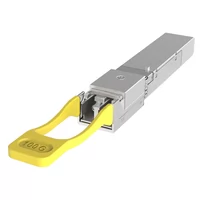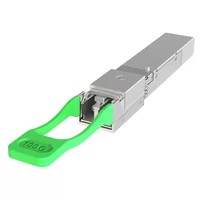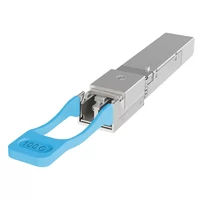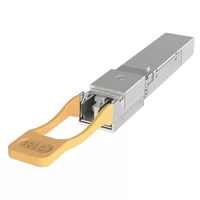At the time, there is a need to support even faster data transfer rates; inside the data communication environment, bandwidth monopolization appears to be a timeless feature. An ideal technological solution to these problems is the 100g Small Form-Factor Pluggable Double Density (SFP-DD) optical transceiver. The device is designed to ensure efficiency in transferring more data within the same uniform area, changing how data centers and networks are structured. The framework develops configurations that allow for vertical network scaling with minimal changes in the hardware deployed. This article explains the saturation and working principles of the 100g SFP-DD module. It focuses on the innovations of 100g SFP-DD that tackle the increasing challenges of digital ecosystems.
Table of Contents
ToggleWhat is the 100g SFP-DD and How Does it Work?
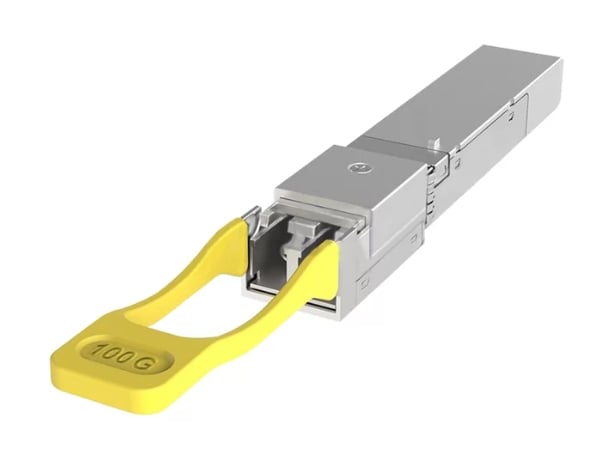
The SFP-DD 100g, short for Small Form-Factor Pluggable Double Density transceiver, is a modern small optical transceiver that aims at high data transfer rates by using double the lane density of former generations. This is possible with the two-channel lanes architecture, which enables the transmission of up to 100 gigabits of data per second. The SFP-DD leverages technology advancements in a small package while providing sufficient performance to service 500m deployment scenarios and be backward compatible with existing technology. It also accommodates the need for increased bandwidth solutions to volatile data centers and network structures by enabling increased signal quality and advanced modulation interfaces for SFP-DD.
Defining the 100g Optical Transceiver Module
The 100g optical transceiver module is a significant milestone in the evolution of technology in fiber optic communication. It is designed to employ a very advanced data architecture to achieve 100 gigabit rates while integrating photonic and electronic components to ensure high speed without compromising energy and other valuable parameters. It links data network devices, for instance, routers and switches, through multi-channel interfaces, which can be used for many applications. These comprise sophisticated laser emitters and high-sensitivity photodetectors for efficient light modulation and detection. The 100g transceiver module has been built to recognize industry requirements and offers easy compatibility with various network elements, allowing its widespread use in high-performance networks.
Exploring the SFP-DD Form Factor
The SFP-DD module type can be termed an advancement over the SFP module with a higher space density and data rate. It does so by adding one more row of electrical contacts and, hence, a net increase of module power dissipation to a total of 3.5 watts per module, which is necessary for the 100G network configurations. This is particularly important for supporting the deployment of 400 gigabit Ethernet with higher port density at data centers. Moreover, the SFP-DD interfaces are designed to maintain backward compatibility with standard SFP modules, empowering telecom operators to expand infrastructure capability without a heavy burden on investment costs. The SFP-DD, thanks to its added bandwidth and small size, is thus positioned to satisfy the telecommunications industry’s ongoing need for more efficient network services.
Functionalities of the Transceiver in Data Centers
Transceivers in data centers fulfill several essential tasks for the seamless transfer of data and the maintenance of networks. They facilitate high-speed communication over long distances by converting electrical and optical signals. Such capability is crucial in providing low-latency and high bandwidth capacities in massive data centers characterized by high-density networks. Transceivers are also advantageous in network design as they allow multiple data rates and network standards to be deployed, making it easy to expand the infrastructure. They are modular, making them easy to service and replace, thus minimizing adequate outage time and maximizing the network traffic performance for the 100G lambda 100G LR1-10 links.
How Does 100g SFP-DD Compare to Other Transceivers?
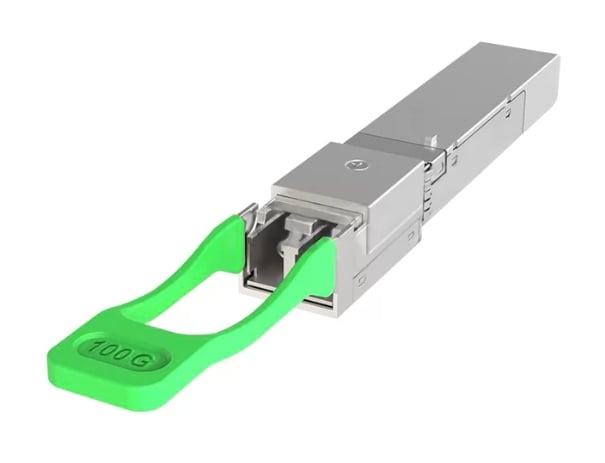
Differentiating 100g SFP56-DD from Other Modules
The 100g SFP56-DD transceiver module outperforms other modules in added data rate, miniaturization, and power consumption. Unlike conventional SFP modules, the SFP56-DD can support data rates of as high as 100 gigabits per second on two channels, addressing the needs of next-generation data center deployments with high bandwidth requirements. Its compactness permits the realization of high port densities, which in turn enhances the spatial efficiency of the networking devices. In addition, the SFP56-DD has been engineered to transmit one gigabit with lower power consumption compared to older models, contributing to energy-saving operations essential for modern high-performance data centers. Such characteristics mean that the 100g SFP56-DD can enable the expansion of networks and new technologies in the future but still be able to use the existing infrastructure.
Understanding the Single Lambda Technology
Single Lambda technology allows data transmission through a single wavelength, enabling high speed. The proposal also states that the approach is more beneficial than the existing approaches that use multiple wavelengths for combined data rates. This is because the complexity of the signal processing, which is enabled by the need for complex multiplexing hardware, is reduced. Single Lambda technology also improves the efficiency of bandwidth consumption by allowing up to 100 gigabits per second of transmission on a single wavelength, which is very important in advancing high-capacity data networks. Its implementation will result in simpler network architectures, improving network operations’ costs and allowing future capacity growth without disruption.
Comparing DSFP and SFP-DD
The DSFP and SFP-DD transceivers mark tremendous technological progress, offering enhanced data transfer efficacy. Both modules intend to make optimum use of the number of ports. In the case of DSFP, this is attained by using two lanes that permit 50G Ethernet per lane. On the other hand, the SFP-DD has the capacity expansion of eight lanes, allowing data rates of as much as 400G Ethernet.
The primary differences occurred in their application contexts: DSFP is applied in numerous situations involving high-speed access and efficient bandwidth management but only at moderate data rates. On the other hand, SFP-DD is better employable in those data centers where the volume of data flow and the functional capacity is exceptionally high. In addition, implementing the SFP-DD is the perfect solution for the evolution of a network from an SFP, SFP28, or SFP112 clamshell module, which makes it also suitable for prospective changes. The two transceivers have specific and unique networking requirements; therefore, performance optimization is possible in varying operational conditions.
What are the Key Compatibility Considerations for 100g SFP-DD?
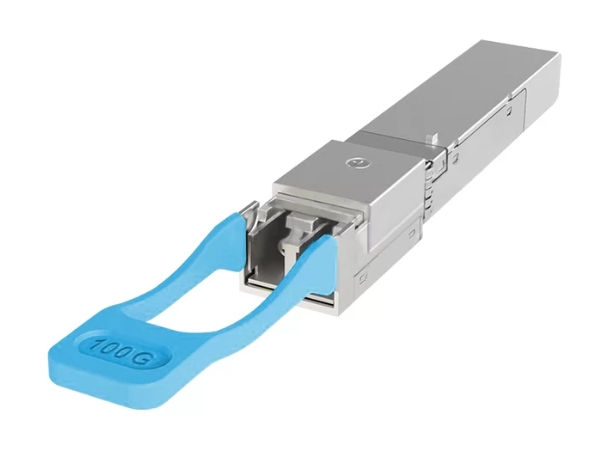
Ensuring Compatibility with Existing Infrastructure
For 100 G SFP-DD transceivers to be initialized with some existing architecture, a few decisions must be resolved. Confirm whether the SFP-DD modules can be hosted in physical interfaces and port spaces of the devices in the networks due to their enhanced designs and specifications. Also, check if the transceivers can operate with the available network protocols; that is, the SFP-DD should be embedded in the construction of the architecture and never get lost. There is also a need for backward compatibility of the SFP module, as upgrading the devices would be smooth since the upgrade wouldn’t need a complete makeover of the networking equipment. Ultimately, it also ensures that the transceiver firmware and the OS get all the necessary upgrades to enable SFP-DD operations while allowing for proper interaction and functioning within the network’s activities. These aspects are essential for integrating the 100G SFP-DD with the existing network, especially if performance and cost optimization are required.
Addressing Data Rate and Bandwidth Concerns
To satisfy the 100G SFP-DD transceiver’s transmission and bandwidth issues, it is essential to guarantee scalable data transfer performances for the service offered over the network. Primarily, the sources noted that the most relevant information from the leading sources is whether the existing equipment will utilize the increased bandwidth provided by the SFP-DD modules, as these transceivers are aimed at much higher data rates. This point, too, must be considered if certain portions of the network are designed to be used at a 100Gbps data rate and cannot be used, thus requiring simultaneous upgrades of cabling or switching infrastructures. Another noteworthy factor is the use of advanced algorithms for error corrections, which allow the data to be transmitted at such high speeds with the desired effect and reliability. Using these measures, operators can seamlessly migrate to 100G SFP-DD transceivers most efficiently and effectively for link distances up to 2km.
How Does the 100g SFP-DD Support Data Centers?
Enhancing Data Center Efficiency with SFP-DD
Because 100G SFP-DD transceivers don’t require more rack space and offer higher data rates, they are a very efficient technology for the data center. As reported by some of the best sources, this type of technology can offer twice the amount of data while taking the same amount of space, which comes in handy while designing organized, compact data centers. Additionally, SFP-DD technology has a higher efficiency, which helps decrease wastage, allowing the data center to operate more economically while also positively affecting the environment. These transceivers also come with the ability to incorporate advanced networking protocols, allowing for the scaling out of the infrastructure and, hence, helping avoid future problems with scaling out operations. All of these improvements enable SFP-DD transceivers to be very beneficial in multi-200G per module scenarios by boosting the performance and efficiency of the data center.
The Role of PAM4 in High-Speed Data Transmission
Pulse Amplitude Modulation 4-Level, or PAM4, is essential for achieving high-speed data transmission, especially for use in data centers that transfer large amounts of data over a short duration. By conveying data in a quad-level code, PAM4 enhances the adequate bandwidth by two times since it increases the bits per symbol to two relative to the two levels used in non-return-to-zero NRZ modulation. This refined modulation scale dramatically enhances the data urgency within the bandwidth resource available and, hence, is a crucial technology for high-speed systems such as 40G links and 100G ethernet. The use of PAM4 also presents new challenges, such as more excellent signal-to-noise ratios and more intricate error-correcting methods; this is especially pertinent for 200G per module applications. Nevertheless, 100G SFP-DD transceivers and other high-speed network elements provide the means for overcoming the challenges associated with deploying PAM4 and, therefore, ensure an upward trend in the mid-long term capacity to address growing data needs.
Utilizing Ethernet Links for Optimal Performance
When it comes to using Ethernet links, what stands out to me from the information on the top sites is how best to use this resource. To begin with, employing high-speed Ethernet standards such as 10G, 25G, and 100G ensures that the network resources can be allocated efficiently for high-usage bandwidth. Deploying quality of service (QoS) settings across the network is critical to underplaying latency by directing all critical data traffic more accurately. Also, it is essential to emphasize the use of structured cabling systems that appropriately incorporate high-speed Ethernet, such that the signal losses and the throughput are optimized. In addition, I also emphasize the constant evaluation and advancement of the network so that the infrastructure stays on a suitable scale and makes it possible to transition seamlessly to the new requirements without any downtime. Using these strategies, I can load high-speed data transmissions to improve computing performance in a particular situation.
What are the Applications of 100g SFP-DD in Networking?
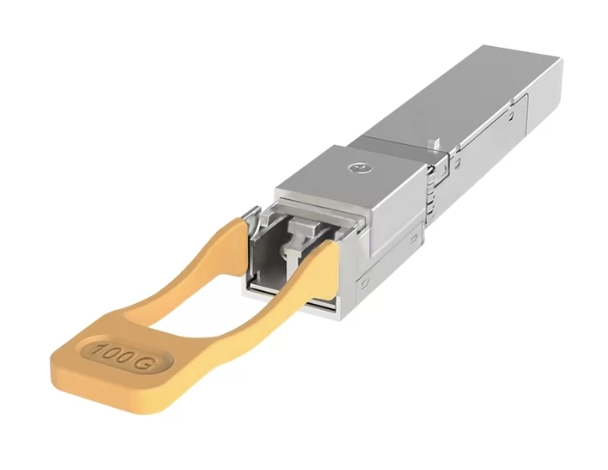
Implementing Ethernet Solutions with SFP-DD
As I have come to grasp from some prominent sources, deploying Ethernet solutions based on SFP-DD transceivers is quite crucial because of their data rate capacity and size as a form. These transceivers allow working with 100G Ethernet, which is essential for data centers and high-performance computing facilities where there is a high demand for data traffic, mostly with sfp56 technology. The SFP-DD form factor implements dual lanes to reach the 100G data rate, which increases port density and lowers the carbon footprint by reducing power consumption. By utilizing SFP-DD transceivers, I simply make sure that our network architecture is ready for the existing needs and even the growth of demands in the foreseeable future, reasonably solving issues like lack of space and energy efficiency without sacrificing the efficiency of operations.
The Significance of 1310nm Wavelength in Optical Networks
The 1310nm wavelength is of immense significance in optical networks because of its low dispersion and attenuation characteristics; thus, it is suitable for short to medium-distance data transfer. This wavelength finds application in single-mode fiber optic systems, as its attributes enable efficient data transmission with minor signal losses and interference, especially on the 100G lambda 100G LR1-10 links. Numerous optical transceivers, including those used in data center operations, are deployed with the 1310nm wavelength to offer robust links and efficient data transmission within an operational radius of about 10 kilometers. So, it is possible to conclude that connectivity issues are solved if 1310nm optimized transceivers are chosen; thus, an organization can achieve higher performance of their network infrastructures while meeting diverse networking requirements.
Benefits and Challenges of Single-Mode Fiber Deployment
Single-mode fiber (SMF) supersedes other fiber types by enabling high-bandwidth and long-distance power transmission. SMF’s higher power distribution can cover several tens of kilometers with lower power transceivers, making it beneficial for high-speed internet, enterprise networks, and telecommunications. Leading industry references testify that single-mode fiber has the potential to minimize latency and interference during transmission, which improves the quality of the signal, which, in this case, is more important in modern data centers and telecommunication centers.
However, with the deployment of single-mode fiber also comes several challenges. The challenge associated with SMF, commonly mentioned by other top sources, is the installation cost, which includes the cost of transceivers that some sectors may find hard to afford financially. Expert analyses also confirm that the installation of SMF requires more accuracy, which means that skilled professionals are needed to ensure minimum signal loss. However the benefits outweigh the challenges, examples of such include a lower total cost of ownership and being able to future proof, factors that make the SMF a favorable option for network infrastructures.
Reference Sources
Frequently Asked Questions (FAQs)
Q: What is an SFP-DD, and what is its significance in the evolution of optical transceiver technology?
A: The SFP-DD (Small Form Factor Pluggable Double Density) is an updated version of an optical module that promises improved data transfer speeds and density while reducing power consumption. It revolutionizes optical transceiver technology by facilitating the conveyance of up to 100g per sfp-dd, which gives it an edge for data center 100g lambda 100g links.
Q: What additional advantages do the 100g DSFP offer compared to QSFP28?
A: The 100g DSFP offers higher density and more efficient bandwidth use than what is possible with 100g ethernet that a single lambda delivered over a ksfp28. While it is true that QSFP28 is ideal for certain 100g uses, the 100g DSFP, on the other hand, is more effective in environments with limited space and high data requirements, such as data centers and fronthaul applications.
Q: Is it true that the maximum transmission distance of SFP-DD LR was set at 10 kilometers?
A: Single-mode fiber (SMF) powers the SFP-DD LR and can extend transmission distances to as far as 10 kilometers. Such capabilities come in handy for inter-data center connections and other long-range applications.
Q: Which wavelengths does the 100g DSFP deal with?
A: The 100G DSFP uses the 1311nm wavelength, which has been modified for optimum use on long-distance fiber optic cables, especially those over 2km. This particular wavelength support helps to achieve high data transmission performance while ensuring less signal distortion.
Q: Do the SFP-DD transceivers support digital diagnostic capabilities?
A: SFP-DD transceivers support digital diagnostic capabilities, making them more effective in links of 100G lambda 100G LR1-10. Such functions are embedded in standard probes for easy access and, therefore, offer real-time management and maintenance of the optical module conditions and overall performance.
Q: What are the advantages of duplex LC connectors with SFP-DD transceivers?
A: Using duplex LC connectors along with sfp and sfp-dd transceivers allows efficient miniaturization of the connections, thereby enabling fast data transmission while minimizing signal loss. This leads to improved performance and enhanced data center and networking system reliability.
Q: What other optical transceivers are available to meet the high-capacity requirements?
A: For higher capacity requirements, one can opt for 400g QSFP-DD, 800g, or 200g OSFP. These modules are ideal for larger data centers and sophisticated networking, providing higher bandwidth and throughput.
Q: How does the SFP-DD MSA enhance interoperability?
A: The SFP-DD MSA (Multi-Source Agreement) affirms that reliance on particular SFP-DD from particular vendors agrees with a standardized form factor and performance specification. This enhances interoperability, which will ease the combining of different suppliers’ optical transceivers integration and deployment, including, but not limited to, SFp56 and SFP112 supporting vendors.
Q: Can SFP-DD be used for 50g and 100g transmission?
A: Yes, the SFP-DD can be propagated to a large extent, accomplishing 50g and even 100g transmission. At the same time, it offers network expansion while working with the current facilities already employed. This allows networks to expand when necessary without major renovations.
Q: 100g Single LR, which applications does this precisely fit within a network application?
A: In any enterprise or data center network, the 100g Single LR is vital for long-distance working without any performance latency. In combination with 100g lambda and 100g lr1-10 standards, it provides optimum distances while maintaining architectural efficiency in modern networks.
Related Products:
-
 SFP-DD-100G-DR 100G SFP56-DD Single Lambda DR 1310nm 500m LC SMF with FEC DDM Optical Transceiver
$345.00
SFP-DD-100G-DR 100G SFP56-DD Single Lambda DR 1310nm 500m LC SMF with FEC DDM Optical Transceiver
$345.00
-
 SFP-DD-100G-FR 100G SFP56-DD FR Single Lambda 1310nm 2km LC SMF with FEC DDM Optical Transceiver
$399.00
SFP-DD-100G-FR 100G SFP56-DD FR Single Lambda 1310nm 2km LC SMF with FEC DDM Optical Transceiver
$399.00
-
 SFP-DD-100G-LR 100G SFP56-DD LR Single Lambda 1310nm 10km LC SMF with FEC DDM Optical Transceiver
$443.00
SFP-DD-100G-LR 100G SFP56-DD LR Single Lambda 1310nm 10km LC SMF with FEC DDM Optical Transceiver
$443.00
-
 SFP-DD-100G-ER 100G SFP56-DD ER Single Lambda 1310nm 40km LC SMF with FEC DDM Optical Transceiver
$1699.00
SFP-DD-100G-ER 100G SFP56-DD ER Single Lambda 1310nm 40km LC SMF with FEC DDM Optical Transceiver
$1699.00

